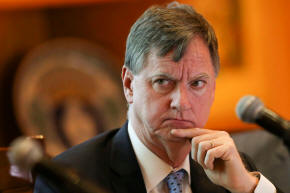|
"Seventy-five (basis points) is a very reasonable place to have
a discussion," Evans told reporters after a talk in Cedar
Rapids, Iowa, when asked about his outlook for the Fed's July
policy decision. "I think 75 would be in line with continued
strong concerns that the inflation data isn't coming down as
quickly as we thought."
The Fed raised rates by 75 basis points last week, to a target
range of 1.5%-1.75%, and most policymakers see the policy rate
at between 3.25%-3.5% by the end of the year.
Fast-rising rates do increase the risk of a downturn, Evans
said.
"We're obviously taking on risk when we want to slow demand, to
keep it in line with supply," Evans said. "To think that we can
fine tune something like this with tremendous precision -- I
mean, we just don't have that ability."
Most Fed policymakers still believe a "soft landing" is
possible, forecasting a slowdown in growth to just below its
long-run trend of 1.8% next year, and an increase in the
unemployment rate, now 3.6%, to 4.1% by 2024.
"The challenge for monetary policy that's always trying to
engineer a soft landing during a rising rate environment is
something else happens and then that's the additional shock that
takes the economy down," he said. That was what happened in
1991, he said, when Iraq's invasion of Kuwait tipped the economy
into recession.
Russia's war in Ukraine and China's COVID lockdowns are among
the risks, but that cannot stop the Fed from doing its job, he
said.
"The first thing that we're looking at is to make sure we take
the steam out of the inflation pressures," he said, adding that
there is "tremendous" consensus at the Fed that rates need to be
high enough to be modestly restrictive on growth.
(Reporting by Ann Saphir; editing by Jonathan Oatis and Chizu
Nomiyama)
[© 2022 Thomson Reuters. All rights
reserved.]
This material may not be published,
broadcast, rewritten or redistributed.
Thompson Reuters is solely responsible for this content.

|
|





